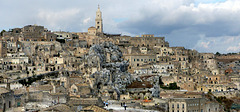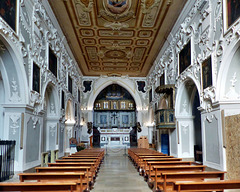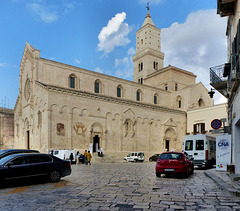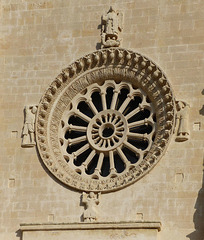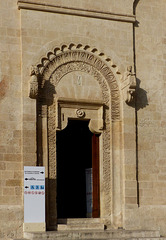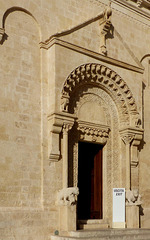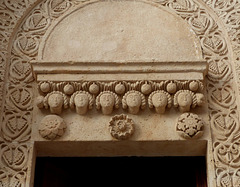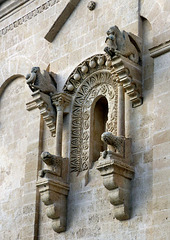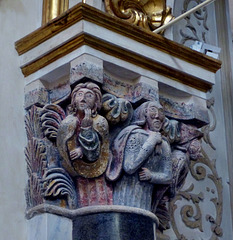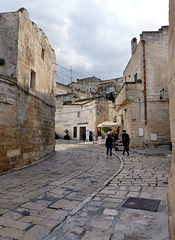
Matera
UNESCO World Heritage Site
Matera - Sasso Caveoso
| |
|
|
The original settlement of Matera lies in two canyons carved by the Gravina River. This area, the Sassi di Matera, is a complex of cave dwellings carved into the ancient river canyon. The settlement is divided into the districts of Sasso Barisano and Sasso Caveoso.
The cave settlements in the area are an exceptional example in the Mediterranean area. Inhabited since the Neolithic Age, Matera can be considered one of the oldest cities in the world.
According to Greek, Roman, Langobard and Byzantine history, which Matera shares with all of southern Italy, Saracens devastated the place in 938. It came under Norman rule in 1043, became a royal seat and thus achieved considerable wealth. This bloom continued under the subsequent regiments of the Staufer and Anjou, in 1270 the cathedral of Matera was completed.
Already by the late 1800s, Matera's cave dwellings became noted for intractable poverty, poor sanitation, meager working conditions, and rampant disease. In 1948, when the city was hit by malaria, 15,000 people lived in 3,300 rooms. From the 1950s on the residents were relocated to newly built apartment blocks. Since the Sassi are now a museum town, tourism is also becoming increasingly important.
Known as la città sotterranea ("the underground city"), the Sassi and the park of the Rupestrian Churches were named a UNESCO World Heritage Site in 1993. In 2019, Matera was declared a European Capital of Culture.
Matera - Sasso Caveoso
| |
|
|
|
The original settlement of Matera lies in two canyons carved by the Gravina River. This area, the Sassi di Matera, is a complex of cave dwellings carved into the ancient river canyon. The settlement is divided into the districts of Sasso Barisano and Sasso Caveoso.
The cave settlements in the area are an exceptional example in the Mediterranean area. Inhabited since the Neolithic Age, Matera can be considered one of the oldest cities in the world.
According to Greek, Roman, Langobard and Byzantine history, which Matera shares with all of southern Italy, Saracens devastated the place in 938. It came under Norman rule in 1043, became a royal seat and thus achieved considerable wealth. This bloom continued under the subsequent regiments of the Staufer and Anjou, in 1270 the cathedral of Matera was completed.
Already by the late 1800s, Matera's cave dwellings became noted for intractable poverty, poor sanitation, meager working conditions, and rampant disease. In 1948, when the city was hit by malaria, 15,000 people lived in 3,300 rooms. From the 1950s on the residents were relocated to newly built apartment blocks. Since the Sassi are now a museum town, tourism is also becoming increasingly important.
Known as la città sotterranea ("the underground city"), the Sassi and the park of the Rupestrian Churches were named a UNESCO World Heritage Site in 1993. In 2019, Matera was declared a European Capital of Culture.
Matera - Sasso Caveoso
| |
|
|
The original settlement of Matera lies in two canyons carved by the Gravina River. This area, the Sassi di Matera, is a complex of cave dwellings carved into the ancient river canyon. The settlement is divided into the districts of Sasso Barisano and Sasso Caveoso.
The cave settlements in the area are an exceptional example in the Mediterranean area. Inhabited since the Neolithic Age, Matera can be considered one of the oldest cities in the world.
According to Greek, Roman, Langobard and Byzantine history, which Matera shares with all of southern Italy, Saracens devastated the place in 938. It came under Norman rule in 1043, became a royal seat and thus achieved considerable wealth. This bloom continued under the subsequent regiments of the Staufer and Anjou, in 1270 the cathedral of Matera was completed.
Already by the late 1800s, Matera's cave dwellings became noted for intractable poverty, poor sanitation, meager working conditions, and rampant disease. In 1948, when the city was hit by malaria, 15,000 people lived in 3,300 rooms. From the 1950s on the residents were relocated to newly built apartment blocks. Since the Sassi are now a museum town, tourism is also becoming increasingly important.
Known as la città sotterranea ("the underground city"), the Sassi and the park of the Rupestrian Churches were named a UNESCO World Heritage Site in 1993. In 2019, Matera was declared a European Capital of Culture.
Matera - San Francesco d'Assisi
| |
|
|
|
The original settlement of Matera lies in two canyons carved by the Gravina River. This area, the Sassi di Matera, is a complex of cave dwellings carved into the ancient river canyon. The settlement is divided into the districts of Sasso Barisano and Sasso Caveoso.
The cave settlements in the area are an exceptional example in the Mediterranean area. Inhabited since the Neolithic Age, Matera can be considered one of the oldest cities in the world.
According to Greek, Roman, Langobard and Byzantine history, which Matera shares with all of southern Italy, Saracens devastated the place in 938. It came under Norman rule in 1043, became a royal seat and thus achieved considerable wealth. This bloom continued under the subsequent regiments of the Staufer and Anjou, in 1270 the cathedral of Matera was completed.
Already by the late 1800s, Matera's cave dwellings became noted for intractable poverty, poor sanitation, meager working conditions, and rampant disease. In 1948, when the city was hit by malaria, 15,000 people lived in 3,300 rooms. From the 1950s on the residents were relocated to newly built apartment blocks. Since the Sassi are now a museum town, tourism is also becoming increasingly important.
Known as la città sotterranea ("the underground city"), the Sassi and the park of the Rupestrian Churches were named a UNESCO World Heritage Site in 1993. In 2019, Matera was declared a European Capital of Culture.
Today Matera has a population of about 60.000, who live in the city "above" the sassi.
The church is the only building that has survived of a monastic complex that was demolished in the 1950s. The Franciscan community settled in Matera in the 13th century and began to erect the first, small church around 1250. The nucleus of the church was an ancient hypogean church. The church has undergone numerous transformations. It got enlarged in the 15th century, to assume its current state in the 18th century with the construction of the baroque facade.
Matera - San Francesco d'Assisi
| |
|
The original settlement of Matera lies in two canyons carved by the Gravina River. This area, the Sassi di Matera, is a complex of cave dwellings carved into the ancient river canyon. The settlement is divided into the districts of Sasso Barisano and Sasso Caveoso.
The cave settlements in the area are an exceptional example in the Mediterranean area. Inhabited since the Neolithic Age, Matera can be considered one of the oldest cities in the world.
According to Greek, Roman, Langobard and Byzantine history, which Matera shares with all of southern Italy, Saracens devastated the place in 938. It came under Norman rule in 1043, became a royal seat and thus achieved considerable wealth. This bloom continued under the subsequent regiments of the Staufer and Anjou, in 1270 the cathedral of Matera was completed.
Already by the late 1800s, Matera's cave dwellings became noted for intractable poverty, poor sanitation, meager working conditions, and rampant disease. In 1948, when the city was hit by malaria, 15,000 people lived in 3,300 rooms. From the 1950s on the residents were relocated to newly built apartment blocks. Since the Sassi are now a museum town, tourism is also becoming increasingly important.
Known as la città sotterranea ("the underground city"), the Sassi and the park of the Rupestrian Churches were named a UNESCO World Heritage Site in 1993. In 2019, Matera was declared a European Capital of Culture.
Today Matera has a population of about 60.000, who live in the city "above" the sassi.
The church is the only building that has survived of a monastic complex that was demolished in the 1950s. The Franciscan community settled in Matera in the 13th century and began to erect the first, small church around 1250. The nucleus of the church was an ancient hypogean church. The church has undergone numerous transformations. It got enlarged in the 15th century, to assume its current state in the 18th century.
Matera - Sasso Caveoso
| |
|
|
The original settlement of Matera lies in two canyons carved by the Gravina River. This area, the Sassi di Matera, is a complex of cave dwellings carved into the ancient river canyon. The settlement is divided into the districts of Sasso Barisano and Sasso Caveoso.
The cave settlements in the area are an exceptional example in the Mediterranean area. Inhabited since the Neolithic Age, Matera can be considered one of the oldest cities in the world.
According to Greek, Roman, Langobard and Byzantine history, which Matera shares with all of southern Italy, Saracens devastated the place in 938. It came under Norman rule in 1043, became a royal seat and thus achieved considerable wealth. This bloom continued under the subsequent regiments of the Staufer and Anjou, in 1270 the cathedral of Matera was completed.
Already by the late 1800s, Matera's cave dwellings became noted for intractable poverty, poor sanitation, meager working conditions, and rampant disease. In 1948, when the city was hit by malaria, 15,000 people lived in 3,300 rooms. From the 1950s on the residents were relocated to newly built apartment blocks. Since the Sassi are now a museum town, tourism is also becoming increasingly important.
Known as la città sotterranea ("the underground city"), the Sassi and the park of the Rupestrian Churches were named a UNESCO World Heritage Site in 1993. In 2019, Matera was declared a European Capital of Culture.
Today Matera has a population of about 60.000, who live in the city "above" the sassi.
Matera - Cattedrale di Matera
| |
|
|
The original settlement of Matera lies in two canyons carved by the Gravina River. This area, the Sassi di Matera, is a complex of cave dwellings carved into the ancient river canyon. The settlement is divided into the districts of Sasso Barisano and Sasso Caveoso.
The cave settlements in the area are an exceptional example in the Mediterranean area. Inhabited since the Neolithic Age, Matera can be considered one of the oldest cities in the world.
According to Greek, Roman, Langobard and Byzantine history, which Matera shares with all of southern Italy, Saracens devastated the place in 938. It came under Norman rule in 1043, became a royal seat and thus achieved considerable wealth. This bloom continued under the subsequent regiments of the Staufer and Anjou, in 1270 the cathedral of Matera was completed.
Already by the late 1800s, Matera's cave dwellings became noted for intractable poverty, poor sanitation, meager working conditions, and rampant disease. In 1948, when the city was hit by malaria, 15,000 people lived in 3,300 rooms. From the 1950s on the residents were relocated to newly built apartment blocks. Since the Sassi are now a museum town, tourism is also becoming increasingly important.
Known as la città sotterranea ("the underground city"), the Sassi and the park of the Rupestrian Churches were named a UNESCO World Heritage Site in 1993. In 2019, Matera was declared a European Capital of Culture.
Today Matera has a population of about 60.000, who live in the city "above" the sassi.
The Matera Cathedral (Cattedrale della Madonna della Bruna e di Sant'Eustachio) was built on the highest point between the two sassi, on the site of the ancient Church of Saint Eustace. The erection in Apulian Romanesque style started in 1230 at the behest of Emperor Frederick II of Swabia, Holy Roman Emperor and Count of Matera. A few years earlier Pope Innocent III had raised Matera to the rank of archdiocese in union with Acerenza. It was completed in 1270.
Unlike the interior which has undergone several transformations over time, the exterior retains its original form almost intact.
Matera - Cattedrale di Matera
| |
|
|
The original settlement of Matera lies in two canyons carved by the Gravina River. This area, the Sassi di Matera, is a complex of cave dwellings carved into the ancient river canyon. The settlement is divided into the districts of Sasso Barisano and Sasso Caveoso.
The cave settlements in the area are an exceptional example in the Mediterranean area. Inhabited since the Neolithic Age, Matera can be considered one of the oldest cities in the world.
According to Greek, Roman, Langobard and Byzantine history, which Matera shares with all of southern Italy, Saracens devastated the place in 938. It came under Norman rule in 1043, became a royal seat and thus achieved considerable wealth. This bloom continued under the subsequent regiments of the Staufer and Anjou, in 1270 the cathedral of Matera was completed.
Already by the late 1800s, Matera's cave dwellings became noted for intractable poverty, poor sanitation, meager working conditions, and rampant disease. In 1948, when the city was hit by malaria, 15,000 people lived in 3,300 rooms. From the 1950s on the residents were relocated to newly built apartment blocks. Since the Sassi are now a museum town, tourism is also becoming increasingly important.
Known as la città sotterranea ("the underground city"), the Sassi and the park of the Rupestrian Churches were named a UNESCO World Heritage Site in 1993. In 2019, Matera was declared a European Capital of Culture.
Today Matera has a population of about 60.000, who live in the city "above" the sassi.
The Matera Cathedral (Cattedrale della Madonna della Bruna e di Sant'Eustachio) was built on the highest point between the two sassi, on the site of the ancient Church of Saint Eustace. The erection in Apulian Romanesque style started in 1230 at the behest of Emperor Frederick II of Swabia, Holy Roman Emperor and Count of Matera. A few years earlier Pope Innocent III had raised Matera to the rank of archdiocese in union with Acerenza. It was completed in 1270.
Unlike the interior which has undergone several transformations over time, the exterior retains its original form almost intact.
The façade is dominated by the rose window, surmounted by the archangel Michael, killing the evil dragon. Two male figures on the sides and another at the bottom that acts as an atlas.
Matera - Cattedrale di Matera
| |
|
|
The original settlement of Matera lies in two canyons carved by the Gravina River. This area, the Sassi di Matera, is a complex of cave dwellings carved into the ancient river canyon. The settlement is divided into the districts of Sasso Barisano and Sasso Caveoso.
The cave settlements in the area are an exceptional example in the Mediterranean area. Inhabited since the Neolithic Age, Matera can be considered one of the oldest cities in the world.
According to Greek, Roman, Langobard and Byzantine history, which Matera shares with all of southern Italy, Saracens devastated the place in 938. It came under Norman rule in 1043, became a royal seat and thus achieved considerable wealth. This bloom continued under the subsequent regiments of the Staufer and Anjou, in 1270 the cathedral of Matera was completed.
Already by the late 1800s, Matera's cave dwellings became noted for intractable poverty, poor sanitation, meager working conditions, and rampant disease. In 1948, when the city was hit by malaria, 15,000 people lived in 3,300 rooms. From the 1950s on the residents were relocated to newly built apartment blocks. Since the Sassi are now a museum town, tourism is also becoming increasingly important.
Known as la città sotterranea ("the underground city"), the Sassi and the park of the Rupestrian Churches were named a UNESCO World Heritage Site in 1993. In 2019, Matera was declared a European Capital of Culture.
Today Matera has a population of about 60.000, who live in the city "above" the sassi.
The Matera Cathedral (Cattedrale della Madonna della Bruna e di Sant'Eustachio) was built on the highest point between the two sassi, on the site of the ancient Church of Saint Eustace. The erection in Apulian Romanesque style started in 1230 at the behest of Emperor Frederick II of Swabia, Holy Roman Emperor and Count of Matera. A few years earlier Pope Innocent III had raised Matera to the rank of archdiocese in union with Acerenza. It was completed in 1270.
Unlike the interior which has undergone several transformations over time, the exterior retains its original form almost intact.
The façade is dominated by the rose window, surmounted by the archangel Michael, killing the evil dragon. Two male figures on the sides and another at the bottom that acts as an atlas.
Matera - Cattedrale di Matera
| |
|
The original settlement of Matera lies in two canyons carved by the Gravina River. This area, the Sassi di Matera, is a complex of cave dwellings carved into the ancient river canyon. The settlement is divided into the districts of Sasso Barisano and Sasso Caveoso.
The cave settlements in the area are an exceptional example in the Mediterranean area. Inhabited since the Neolithic Age, Matera can be considered one of the oldest cities in the world.
According to Greek, Roman, Langobard and Byzantine history, which Matera shares with all of southern Italy, Saracens devastated the place in 938. It came under Norman rule in 1043, became a royal seat and thus achieved considerable wealth. This bloom continued under the subsequent regiments of the Staufer and Anjou, in 1270 the cathedral of Matera was completed.
Already by the late 1800s, Matera's cave dwellings became noted for intractable poverty, poor sanitation, meager working conditions, and rampant disease. In 1948, when the city was hit by malaria, 15,000 people lived in 3,300 rooms. From the 1950s on the residents were relocated to newly built apartment blocks. Since the Sassi are now a museum town, tourism is also becoming increasingly important.
Known as la città sotterranea ("the underground city"), the Sassi and the park of the Rupestrian Churches were named a UNESCO World Heritage Site in 1993. In 2019, Matera was declared a European Capital of Culture.
Today Matera has a population of about 60.000, who live in the city "above" the sassi.
The Matera Cathedral (Cattedrale della Madonna della Bruna e di Sant'Eustachio) was built on the highest point between the two sassi, on the site of the ancient Church of Saint Eustace. The erection in Apulian Romanesque style started in 1230 at the behest of Emperor Frederick II of Swabia, Holy Roman Emperor and Count of Matera. A few years earlier Pope Innocent III had raised Matera to the rank of archdiocese in union with Acerenza. It was completed in 1270.
Unlike the interior which has undergone several transformations over time, the exterior retains its original form almost intact.
Next to the window a very weathered mermaid seems to sunbathe.
Matera - Cattedrale di Matera
| |
|
The original settlement of Matera lies in two canyons carved by the Gravina River. This area, the Sassi di Matera, is a complex of cave dwellings carved into the ancient river canyon. The settlement is divided into the districts of Sasso Barisano and Sasso Caveoso.
The cave settlements in the area are an exceptional example in the Mediterranean area. Inhabited since the Neolithic Age, Matera can be considered one of the oldest cities in the world.
According to Greek, Roman, Langobard and Byzantine history, which Matera shares with all of southern Italy, Saracens devastated the place in 938. It came under Norman rule in 1043, became a royal seat and thus achieved considerable wealth. This bloom continued under the subsequent regiments of the Staufer and Anjou, in 1270 the cathedral of Matera was completed.
Already by the late 1800s, Matera's cave dwellings became noted for intractable poverty, poor sanitation, meager working conditions, and rampant disease. In 1948, when the city was hit by malaria, 15,000 people lived in 3,300 rooms. From the 1950s on the residents were relocated to newly built apartment blocks. Since the Sassi are now a museum town, tourism is also becoming increasingly important.
Known as la città sotterranea ("the underground city"), the Sassi and the park of the Rupestrian Churches were named a UNESCO World Heritage Site in 1993. In 2019, Matera was declared a European Capital of Culture.
Today Matera has a population of about 60.000, who live in the city "above" the sassi.
The Matera Cathedral (Cattedrale della Madonna della Bruna e di Sant'Eustachio) was built on the highest point between the two sassi, on the site of the ancient Church of Saint Eustace. The erection in Apulian Romanesque style started in 1230 at the behest of Emperor Frederick II of Swabia, Holy Roman Emperor and Count of Matera. A few years earlier Pope Innocent III had raised Matera to the rank of archdiocese in union with Acerenza. It was completed in 1270.
Unlike the interior which has undergone several transformations over time, the exterior retains its original form almost intact.
The two atlants are on their knees and groan since centuries under the pillars weight.
Matera - Cattedrale di Matera
| |
|
The original settlement of Matera lies in two canyons carved by the Gravina River. This area, the Sassi di Matera, is a complex of cave dwellings carved into the ancient river canyon. The settlement is divided into the districts of Sasso Barisano and Sasso Caveoso.
The cave settlements in the area are an exceptional example in the Mediterranean area. Inhabited since the Neolithic Age, Matera can be considered one of the oldest cities in the world.
According to Greek, Roman, Langobard and Byzantine history, which Matera shares with all of southern Italy, Saracens devastated the place in 938. It came under Norman rule in 1043, became a royal seat and thus achieved considerable wealth. This bloom continued under the subsequent regiments of the Staufer and Anjou, in 1270 the cathedral of Matera was completed.
Already by the late 1800s, Matera's cave dwellings became noted for intractable poverty, poor sanitation, meager working conditions, and rampant disease. In 1948, when the city was hit by malaria, 15,000 people lived in 3,300 rooms. From the 1950s on the residents were relocated to newly built apartment blocks. Since the Sassi are now a museum town, tourism is also becoming increasingly important.
Known as la città sotterranea ("the underground city"), the Sassi and the park of the Rupestrian Churches were named a UNESCO World Heritage Site in 1993. In 2019, Matera was declared a European Capital of Culture.
Today Matera has a population of about 60.000, who live in the city "above" the sassi.
The Matera Cathedral (Cattedrale della Madonna della Bruna e di Sant'Eustachio) was built on the highest point between the two sassi, on the site of the ancient Church of Saint Eustace. The erection in Apulian Romanesque style started in 1230 at the behest of Emperor Frederick II of Swabia, Holy Roman Emperor and Count of Matera. A few years earlier Pope Innocent III had raised Matera to the rank of archdiocese in union with Acerenza. It was completed in 1270.
Unlike the interior which has undergone several transformations over time, the exterior retains its original form almost intact.
Two monks guard this lavishly decorated door. The right monk is still pretty undamaged, while the left one has lost both hands and his head.
Matera - Cattedrale di Matera
| |
|
The original settlement of Matera lies in two canyons carved by the Gravina River. This area, the Sassi di Matera, is a complex of cave dwellings carved into the ancient river canyon. The settlement is divided into the districts of Sasso Barisano and Sasso Caveoso.
The cave settlements in the area are an exceptional example in the Mediterranean area. Inhabited since the Neolithic Age, Matera can be considered one of the oldest cities in the world.
According to Greek, Roman, Langobard and Byzantine history, which Matera shares with all of southern Italy, Saracens devastated the place in 938. It came under Norman rule in 1043, became a royal seat and thus achieved considerable wealth. This bloom continued under the subsequent regiments of the Staufer and Anjou, in 1270 the cathedral of Matera was completed.
Already by the late 1800s, Matera's cave dwellings became noted for intractable poverty, poor sanitation, meager working conditions, and rampant disease. In 1948, when the city was hit by malaria, 15,000 people lived in 3,300 rooms. From the 1950s on the residents were relocated to newly built apartment blocks. Since the Sassi are now a museum town, tourism is also becoming increasingly important.
Known as la città sotterranea ("the underground city"), the Sassi and the park of the Rupestrian Churches were named a UNESCO World Heritage Site in 1993. In 2019, Matera was declared a European Capital of Culture.
Today Matera has a population of about 60.000, who live in the city "above" the sassi.
The Matera Cathedral (Cattedrale della Madonna della Bruna e di Sant'Eustachio) was built on the highest point between the two sassi, on the site of the ancient Church of Saint Eustace. The erection in Apulian Romanesque style started in 1230 at the behest of Emperor Frederick II of Swabia, Holy Roman Emperor and Count of Matera. A few years earlier Pope Innocent III had raised Matera to the rank of archdiocese in union with Acerenza. It was completed in 1270.
Unlike the interior which has undergone several transformations over time, the exterior retains its original form almost intact.
This side portal, protected by two devouring lions and two (decapitated) eagles is even more complex that the other one (prev. upload).
Matera - Cattedrale di Matera
| |
|
The original settlement of Matera lies in two canyons carved by the Gravina River. This area, the Sassi di Matera, is a complex of cave dwellings carved into the ancient river canyon. The settlement is divided into the districts of Sasso Barisano and Sasso Caveoso.
The cave settlements in the area are an exceptional example in the Mediterranean area. Inhabited since the Neolithic Age, Matera can be considered one of the oldest cities in the world.
According to Greek, Roman, Langobard and Byzantine history, which Matera shares with all of southern Italy, Saracens devastated the place in 938. It came under Norman rule in 1043, became a royal seat and thus achieved considerable wealth. This bloom continued under the subsequent regiments of the Staufer and Anjou, in 1270 the cathedral of Matera was completed.
Already by the late 1800s, Matera's cave dwellings became noted for intractable poverty, poor sanitation, meager working conditions, and rampant disease. In 1948, when the city was hit by malaria, 15,000 people lived in 3,300 rooms. From the 1950s on the residents were relocated to newly built apartment blocks. Since the Sassi are now a museum town, tourism is also becoming increasingly important.
Known as la città sotterranea ("the underground city"), the Sassi and the park of the Rupestrian Churches were named a UNESCO World Heritage Site in 1993. In 2019, Matera was declared a European Capital of Culture.
Today Matera has a population of about 60.000, who live in the city "above" the sassi.
The Matera Cathedral (Cattedrale della Madonna della Bruna e di Sant'Eustachio) was built on the highest point between the two sassi, on the site of the ancient Church of Saint Eustace. The erection in Apulian Romanesque style started in 1230 at the behest of Emperor Frederick II of Swabia, Holy Roman Emperor and Count of Matera. A few years earlier Pope Innocent III had raised Matera to the rank of archdiocese in union with Acerenza. It was completed in 1270.
Unlike the interior which has undergone several transformations over time, the exterior retains its original form almost intact.
The side portal (prev. upload) has this interesting lintel.
Matera - Cattedrale di Matera
| |
|
|
The original settlement of Matera lies in two canyons carved by the Gravina River. This area, the Sassi di Matera, is a complex of cave dwellings carved into the ancient river canyon. The settlement is divided into the districts of Sasso Barisano and Sasso Caveoso.
The cave settlements in the area are an exceptional example in the Mediterranean area. Inhabited since the Neolithic Age, Matera can be considered one of the oldest cities in the world.
According to Greek, Roman, Langobard and Byzantine history, which Matera shares with all of southern Italy, Saracens devastated the place in 938. It came under Norman rule in 1043, became a royal seat and thus achieved considerable wealth. This bloom continued under the subsequent regiments of the Staufer and Anjou, in 1270 the cathedral of Matera was completed.
Already by the late 1800s, Matera's cave dwellings became noted for intractable poverty, poor sanitation, meager working conditions, and rampant disease. In 1948, when the city was hit by malaria, 15,000 people lived in 3,300 rooms. From the 1950s on the residents were relocated to newly built apartment blocks. Since the Sassi are now a museum town, tourism is also becoming increasingly important.
Known as la città sotterranea ("the underground city"), the Sassi and the park of the Rupestrian Churches were named a UNESCO World Heritage Site in 1993. In 2019, Matera was declared a European Capital of Culture.
Today Matera has a population of about 60.000, who live in the city "above" the sassi.
The Matera Cathedral (Cattedrale della Madonna della Bruna e di Sant'Eustachio) was built on the highest point between the two sassi, on the site of the ancient Church of Saint Eustace. The erection in Apulian Romanesque style started in 1230 at the behest of Emperor Frederick II of Swabia, Holy Roman Emperor and Count of Matera. A few years earlier Pope Innocent III had raised Matera to the rank of archdiocese in union with Acerenza. It was completed in 1270.
Unlike the interior which has undergone several transformations over time, the exterior retains its original form almost intact.
A "window frame". Two lions, devouring rams, and above them two griffons as well torturing and devouring creatures.
Matera - Cattedrale di Matera
| |
|
The original settlement of Matera lies in two canyons carved by the Gravina River. This area, the Sassi di Matera, is a complex of cave dwellings carved into the ancient river canyon. The settlement is divided into the districts of Sasso Barisano and Sasso Caveoso.
The cave settlements in the area are an exceptional example in the Mediterranean area. Inhabited since the Neolithic Age, Matera can be considered one of the oldest cities in the world.
According to Greek, Roman, Langobard and Byzantine history, which Matera shares with all of southern Italy, Saracens devastated the place in 938. It came under Norman rule in 1043, became a royal seat and thus achieved considerable wealth. This bloom continued under the subsequent regiments of the Staufer and Anjou, in 1270 the cathedral of Matera was completed.
Already by the late 1800s, Matera's cave dwellings became noted for intractable poverty, poor sanitation, meager working conditions, and rampant disease. In 1948, when the city was hit by malaria, 15,000 people lived in 3,300 rooms. From the 1950s on the residents were relocated to newly built apartment blocks. Since the Sassi are now a museum town, tourism is also becoming increasingly important.
Known as la città sotterranea ("the underground city"), the Sassi and the park of the Rupestrian Churches were named a UNESCO World Heritage Site in 1993. In 2019, Matera was declared a European Capital of Culture.
Today Matera has a population of about 60.000, who live in the city "above" the sassi.
The Matera Cathedral (Cattedrale della Madonna della Bruna e di Sant'Eustachio) was built on the highest point between the two sassi, on the site of the ancient Church of Saint Eustace. The erection in Apulian Romanesque style started in 1230 at the behest of Emperor Frederick II of Swabia, Holy Roman Emperor and Count of Matera. A few years earlier Pope Innocent III had raised Matera to the rank of archdiocese in union with Acerenza. It was completed in 1270.
The interior has undergone several transformations over time, but the Romanesque structure is still visible.
Matera - Cattedrale di Matera
| |
|
The original settlement of Matera lies in two canyons carved by the Gravina River. This area, the Sassi di Matera, is a complex of cave dwellings carved into the ancient river canyon. The settlement is divided into the districts of Sasso Barisano and Sasso Caveoso.
The cave settlements in the area are an exceptional example in the Mediterranean area. Inhabited since the Neolithic Age, Matera can be considered one of the oldest cities in the world.
According to Greek, Roman, Langobard and Byzantine history, which Matera shares with all of southern Italy, Saracens devastated the place in 938. It came under Norman rule in 1043, became a royal seat and thus achieved considerable wealth. This bloom continued under the subsequent regiments of the Staufer and Anjou, in 1270 the cathedral of Matera was completed.
Already by the late 1800s, Matera's cave dwellings became noted for intractable poverty, poor sanitation, meager working conditions, and rampant disease. In 1948, when the city was hit by malaria, 15,000 people lived in 3,300 rooms. From the 1950s on the residents were relocated to newly built apartment blocks. Since the Sassi are now a museum town, tourism is also becoming increasingly important.
Known as la città sotterranea ("the underground city"), the Sassi and the park of the Rupestrian Churches were named a UNESCO World Heritage Site in 1993. In 2019, Matera was declared a European Capital of Culture.
Today Matera has a population of about 60.000, who live in the city "above" the sassi.
The Matera Cathedral (Cattedrale della Madonna della Bruna e di Sant'Eustachio) was built on the highest point between the two sassi, on the site of the ancient Church of Saint Eustace. The erection in Apulian Romanesque style started in 1230 at the behest of Emperor Frederick II of Swabia, Holy Roman Emperor and Count of Matera. A few years earlier Pope Innocent III had raised Matera to the rank of archdiocese in union with Acerenza. It was completed in 1270.
The interior has undergone several transformations over time, but the Romanesque structure is still visible. The capitals look Romanesque, but they seem so "mint", that I reckon they are the result of restoration.
Matera - Sassi
| |
|
|
The original settlement of Matera lies in two canyons carved by the Gravina River. This area, the Sassi di Matera, is a complex of cave dwellings carved into the ancient river canyon. The settlement is divided into the districts of Sasso Barisano and Sasso Caveoso.
The cave settlements in the area are an exceptional example in the Mediterranean area. Inhabited since the Neolithic Age, Matera can be considered one of the oldest cities in the world.
According to Greek, Roman, Langobard and Byzantine history, which Matera shares with all of southern Italy, Saracens devastated the place in 938. It came under Norman rule in 1043, became a royal seat and thus achieved considerable wealth. This bloom continued under the subsequent regiments of the Staufer and Anjou, in 1270 the cathedral of Matera was completed.
Already by the late 1800s, Matera's cave dwellings became noted for intractable poverty, poor sanitation, meager working conditions, and rampant disease. In 1948, when the city was hit by malaria, 15,000 people lived in 3,300 rooms. From the 1950s on the residents were relocated to newly built apartment blocks. Since the Sassi are now a museum town, tourism is also becoming increasingly important.
Known as la città sotterranea ("the underground city"), the Sassi and the park of the Rupestrian Churches were named a UNESCO World Heritage Site in 1993. In 2019, Matera was declared a European Capital of Culture.
Today Matera has a population of about 60.000, who live in the city "above" the sassi, where only a few lanes are wide enough for vehicles.
Jump to top
RSS feed- Latest items - Subscribe to the latest items added to this album
- ipernity © 2007-2024
- Help & Contact
|
Club news
|
About ipernity
|
History |
ipernity Club & Prices |
Guide of good conduct
Donate | Group guidelines | Privacy policy | Terms of use | Statutes | In memoria -
Facebook
Twitter


